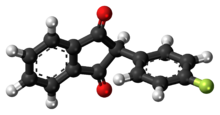
| |

| |
| Names | |
|---|---|
| Preferred IUPAC name 2-(4-Fluorophenyl)-1H-indene-1,3(2H)-dione | |
| Identifiers | |
| CAS Number | |
| 3D model (JSmol) | |
| ChemSpider | |
| ECHA InfoCard | 100.012.258 |
| EC Number |
|
| KEGG | |
| MeSH | C017673 |
| PubChem CID | |
| UNII | |
| CompTox Dashboard (EPA) | |
InChI
| |
SMILES
| |
| Properties | |
| Chemical formula | C15H9FO2 |
| Molar mass | 240.233 g·mol |
| Pharmacology | |
| ATC code | B01AA12 (WHO) |
| Except where otherwise noted, data are given for materials in their standard state (at 25 °C , 100 kPa).
| |
Fluindione is a vitamin K antagonist It is used as an anticoagulant.
References
- Mentré F, Pousset F, Comets E, et al. (January 1998). "Population pharmacokinetic-pharmacodynamic analysis of fluindione in patients". Clin. Pharmacol. Ther. 63 (1): 64–78. doi:10.1016/S0009-9236(98)90122-9. PMID 9465843. S2CID 24087650.
This drug article relating to the blood and blood forming organs is a stub. You can help Misplaced Pages by expanding it. |